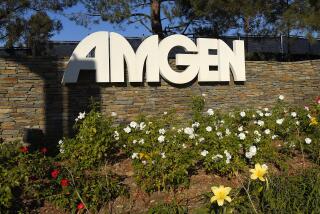Amgen needs mojo working
- Share via
Standing in front of a packed room of investors at a San Francisco conference early this year, Kevin Sharer took a repentant tone.
He first flipped to a slide labeled: “One Year Ago, We Were in a Good Spot.” The chief executive documented how Amgen’s revenue increased nearly 30% from 2001 to 2006. Then he deadpanned: “What a difference a year can make.”
For Amgen Inc., Sharer’s assessment couldn’t be more true.
The Thousand Oaks biotech pioneer that could do no wrong for most of its 25-year history is increasingly at risk of losing its place atop the spectacularly lucrative but equally treacherous biotech industry.
In recent months, the company has scaled back manufacturing facilities, cut nearly one-sixth of its workforce and has taken the frugal step of selling some of its drug distribution rights, as it did last month to a Japanese drug company.
The company’s prospects seem sufficiently glum that Wall Street has begun talking about Amgen as a possible takeover target. Pfizer Inc. is often named as a potential suitor although both companies have publicly dismissed the possibility.
Meanwhile, the relentless assault on Amgen’s top-selling anemia franchise -- Aranesp and Epogen -- may be continuing. The medications increase red blood cell production to treat people who have cancer or are on dialysis.
Studies have suggested the drugs can increase tumor growth in some cancer patients, especially at higher doses.
In recent months, federal health officials have imposed labeling and reimbursement restrictions on the drugs. Aranesp sales fell nearly 20% last year to $3.2 billion, according to healthcare research firm IMS Health Inc..
On Tuesday, the Food and Drug Administration released materials in advance of the meeting of an advisory panel scheduled later this week that will review safety data regarding the drugs.
In a potentially worrisome development, the documents appeared to raise the possibility that regulators might consider urging doctors not to prescribe the medications for patients with some -- possibly all -- cancers.
“There is now mounting evidence of documented effects on survival, tumor progression and [blood-clotting] events which require a reassessment of the net benefits of this class of drugs,” FDA staff members wrote in an analysis prepared for the panel.
Although it remains unlikely regulators will significantly curtail the drugs’ use in oncology, analysts say, a decrease in sales for treatment of all cancers could shave $750 million to $1 billion from Amgen’s 2008 revenue estimates. Limiting their use to only some cancers could reduce yearly sales by as much as $250 million.
The agency proposed another option for patients taking the drugs. Under the plan, patients could sign a consent form agreeing to the risks.
In a statement, the company appeared to support such an idea saying it “strongly believes that [the drugs] provide an important clinical option for some patients, and looks forward to collaborating with . . . the FDA to maximize the benefits of these drugs when used according to the approved labeling while minimizing the risks.”
No matter how this week’s meeting goes, Amgen faces another -- and perhaps larger -- problem: It is believed to have only a thin pipeline of new drugs in development to replace aging flagship medicines whose sales are weakening.
The company’s most promising candidate under development is a bone-building drug known as denosumab, or D-mab, to treat post-menopausal osteoporosis patients and cancer patients.
The drug was found after laboratory research unexpectedly led to oversized mice with big bones. Early clinical results are very promising. The drug is expected to be injected twice yearly in a doctor’s office and cost about $1,000 a year.
Still, the pharmaceutical industry is littered with high-profile drug candidates that fail to take off after winning approval, if they ever do.
Moreover, Merck & Co.’s top-selling osteoporosis drug, Fosamax, is set to go generic this year.
It is too soon to know whether doctors would prescribe denosumab or other bone treatments that are significantly more expensive than a generic Fosamax.
“If D-mab is perceived -- as it seems -- to not have an obvious advantage over the currently available therapies [such as the soon-to-be-generic Fosamax] . . . then it will probably be relegated to second or third line in this setting,” wrote Friedman, Billings, Ramsey biotech analyst Jim Reddoch, in a recent research note.
Enthusiasm has also waned over several other Amgen drugs under development. And a high-profile trial to expand the use of the company’s colon cancer drug was stopped last year after preliminary findings found safety concerns.
Amgen denied repeated requests to make Sharer or other senior executives available for interview. In an e-mail, spokesman David Polk said it would be “misleading” to characterize Amgen as having a thin drug pipeline and said the company could weather its current regulatory and market challenges.
Other drug companies, of course, face their own challenges. Pfizer’s $13 billion yearly revenue from its cholesterol fighter Lipitor could face generic competition as soon as 2010. More drug makers are laying off workers as revenues decline industrywide.
Amgen continues to have many admirers who point to the company’s strong track record as evidence it will continue to deliver profit. But the swift and severe turn of the company’s fortunes has surprised even veteran industry watchers.
In recent months, Sharer and other Amgen executives have outlined strategies to return the company to growth, largely by promoting innovation in its own labs.
Flush with cash, a big acquisition may also be tempting -- although the company’s acquisition history is bumpy.
In 2002, Amgen paid an estimated $16 billion to buy Immunex Corp. and gain its rheumatoid arthritis and psoriasis drug Enbrel. Last year, the drug pulled in nearly $3 billion although sales are declining as more competitors arrive on the market.
Other acquisition opportunities were missed. For instance, the company decided against entering discussions earlier this decade to invest in the market for AIDS biotech drugs, a long-overlooked sector that has unexpectedly turned competitors such as Foster City, Calif-based Gilead Sciences Inc. into industry stars.
And, in a previously undisclosed deal, Sharer and top executives flew to the New Jersey headquarters of Celgene Corp. in 2006 and agreed in principle to acquire the maker of several profitable cancer drugs for about $12 billion.
Amgen executives later pulled the offer after deciding the deal wasn’t worthwhile, according to a person familiar with the matter who asked not to be identified because they were not authorized to speak. Celgene’s current market value is $23 billion.
In an interview this week with the Wall Street Journal, Sharer said Amgen wasn’t interested in merging with a larger company and that Amgen expected to continue developing the company’s pipeline alone. “What I’m worried about is managing Amgen to the best of our ability,” he said.
Some investors, however, appear to be growing restless.
On Tuesday, Amgen’s stock fell to one of its lowest levels in five years, down 0.13% to $44.62.
Michael Aberman, a biotech analyst with Credit Suisse Group, said in an interview that it may be time for investors to consider putting more pressure on Amgen to make management changes. (To date, Sharer and other senior managers appear to have the strong backing of the company’s board.)
“I’m surprised there hasn’t been more scrutiny,” Aberman said. “I think at some point management has to be held accountable for taking what was an innovative, market-leading biotech company and turning it into what it is today.”
--
More to Read
Inside the business of entertainment
The Wide Shot brings you news, analysis and insights on everything from streaming wars to production — and what it all means for the future.
You may occasionally receive promotional content from the Los Angeles Times.










